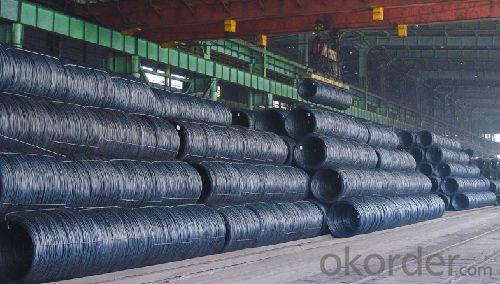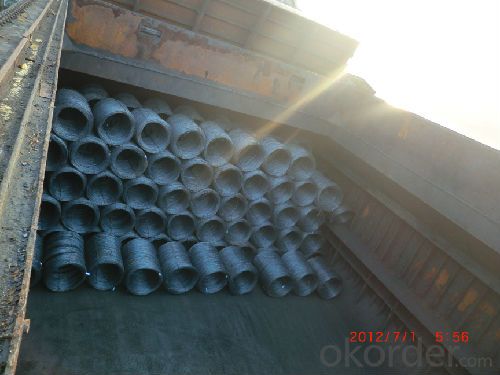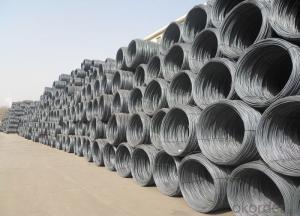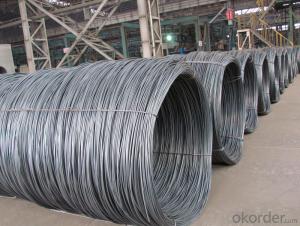Prime Hot Rolled Carbon Steel Wire Rod
- Loading Port:
- China Main Port
- Payment Terms:
- TT or LC
- Min Order Qty:
- 100 m.t.
- Supply Capability:
- 10000 m.t./month
OKorder Service Pledge
OKorder Financial Service
You Might Also Like
Product Description:
OKorder is offering Prime Hot Rolled Carbon Steel Wire Rod at great prices with worldwide shipping. Our supplier is a world-class manufacturer of steel, with our products utilized the world over. OKorder annually supplies products to African, South American and Asian markets. We provide quotations within 24 hours of receiving an inquiry and guarantee competitive prices.
Product Applications:
Prime Hot Rolled Carbon Steel Wire Rod are ideal for structural applications and are widely used in construction and manufacturing. Carbon steel wire rod is mainly used for reinforcement of reinforced concrete and welded structure or reprocessed (roberts , nail, etc.) materials, especially used to produce wire drawing, welding electrode, nails, spring, electronic, precise machinery parts and so on.
Product Advantages:
OKorder's Prime Hot Rolled Carbon Steel Wire Rod are durable, strong, and wide variety of sizes.
Main Product Features:
· Premium quality
· Prompt delivery & seaworthy packing (30 days after receiving deposit)
· Can be recycled and reused
· Mill test certification
· Professional Service
· Competitive pricing
Product Specifications:
Steel Grade: SAE1006-1018B
Standard: ASTM, GB
Diameter: 5.5mm, 6.5mm, 7mm,8mm,9mm,10mm,12mm,14mm
Type: in coil, coil weight around 2MT
Alloy or Not: Alloy
Technique: Hot Rolled
Place of Origin: China Mainland
Surface: round, no twisted, light and smooth
Trademark | Rank | Chemical composition (quality score) % | ||||||
C | Si | Mn | S | P | ||||
| ≤ |
| ≤ | ≤ | ||||
Q195 |
| 0.06-0.12 | 0.30 | 0.25 | 0.050 | 0.045 | ||
Q235 | A | 0.14-0.22 | 0.30 | 0.30-0.65 | 0.050 | 0.045 | ||
Q235 | B | 0.12-0.20 | 0.30 | 0.30-0.70 | 0.045 | 0.045 | ||
FAQ:
Q1: How many tons of steel products could be loaded in containers?
A1: Usually the steel products are delivered by bulk vessel because of the large quantity and the freight. However, there are no bulk vessel enter some seaports so that we have to deliver the cargo by containers. The 6m steel product can be loaded in 20FT container, but the quantity is changed according to the size, usually from 18tons to 25tons.
Q2: How do we guarantee the quality of our products?
A2: We have established an advanced quality management system which conducts strict quality tests at every step, from raw materials to the final product. At the same time, we provide extensive follow-up service assurances as required.
Q3: How soon can we receive the product after purchase?
A3: Within three days of placing an order, we will arrange production. The normal sizes with the normal grade can be produced within one month. The specific shipping date is dependent upon international and government factors, the delivery to international main port about 45-60days.
Images:


- Q:How is the impact resistance of steel wire rod tested?
- The impact resistance of steel wire rod is typically tested using a Charpy impact test. In this test, a notched specimen of the wire rod is subjected to a swinging pendulum that strikes and breaks the specimen. The energy absorbed by the specimen during fracture is measured, which provides an indication of its impact resistance.
- Q:What are the different surface defects that can occur in steel wire rod?
- There are several common surface defects that can occur in steel wire rods, including scale, scratches, pits, seams, and cracks. These defects can occur during the manufacturing process or as a result of handling and transportation. It is important to identify and address these defects to ensure the quality and performance of the steel wire rod.
- Q:How is the mechanical strength of steel wire rod assessed?
- The mechanical strength of steel wire rod is typically assessed through various tests such as tensile testing, hardness testing, and impact testing. These tests help determine the wire rod's ability to withstand pulling forces, resist deformation, and absorb energy upon impact, respectively. Additionally, other factors such as yield strength, ultimate tensile strength, and elongation are also considered in assessing the mechanical strength of steel wire rod.
- Q:How is the diameter of steel wire rod measured?
- To determine the diameter of a steel wire rod, one commonly employs a micrometer, a specialized precision measuring instrument. This device is specifically crafted to achieve precise measurements of small distances or thicknesses. Comprising a calibrated screw mechanism paired with a spindle, the micrometer is meticulously manipulated until it delicately makes contact with the wire rod's surface. The resulting measurement is subsequently read from the micrometer's scale, which frequently incorporates both metric and imperial units. By employing this technique, one guarantees precise and uniform determination of steel wire rod diameters.
- Q:How is steel wire rod used in the manufacturing of wire mesh baskets?
- Steel wire rod is used in the manufacturing of wire mesh baskets as the primary raw material. It is first drawn into thinner wires, which are then woven or welded together to form the mesh structure of the basket. The strong and durable nature of steel wire rod ensures that the wire mesh baskets have sufficient strength and stability to hold various items securely.
- Q:How is steel wire rod different from steel bar?
- Steel wire rod and steel bar are both made from steel, but they differ in terms of their shape and size. Steel wire rod is typically a long, thin cylindrical shape with a smaller diameter, often used for various applications such as in the production of wire, nails, and screws. On the other hand, steel bar refers to a solid, straight piece of steel that is thicker and has a larger diameter compared to wire rod. Steel bars are commonly used in construction projects, manufacturing machinery, and as reinforcement in concrete structures.
- Q:What are the different shapes of steel wire rod?
- Steel wire rods are available in a variety of shapes and sizes, each with its own specific properties and applications. Here are some common shapes: 1. Round wire rods: This shape is widely used for general purposes like fencing, construction, and manufacturing various products. Round wire rods offer great strength and versatility. 2. Square wire rods: With four equal sides, these rods provide additional strength and stability. They are commonly used in applications such as manufacturing springs, fasteners, and electrical wiring. 3. Flat wire rods: Featuring a rectangular cross-section, flat rods are suitable for applications that require a wide but thin surface area. They find use in the manufacturing of automotive parts, furniture, and conveyor belts. 4. Hexagonal wire rods: These rods have six sides and are ideal for applications that require a higher grip or torque. They are commonly used in the manufacturing of nuts, bolts, and mechanical components. 5. Deformed wire rods: Deformed rods have ridges or deformations on their surface, enhancing their bonding properties. They are suitable for reinforcement purposes, such as in the production of reinforcing bars (rebars) used in construction projects. These examples represent only a few of the available shapes of steel wire rods. The choice of shape depends on specific application requirements, including strength, stability, grip, and bonding properties.
- Q:What are the different types of defects that can occur in steel wire rod?
- There are several different types of defects that can occur in steel wire rods. These defects can arise during the manufacturing process or as a result of various external factors. Some common types of defects include surface defects, internal defects, and dimensional defects. Surface defects are often the most visible and can include scratches, pits, cracks, and scale. These defects can occur due to improper handling or storage of the wire rod, as well as issues during the rolling or finishing processes. Surface defects can affect the appearance and functionality of the wire rod and may require further processing or treatment to rectify. Internal defects are defects that occur within the structure of the wire rod and are not visible from the surface. These defects can include inclusions, voids, and segregations. Inclusions are foreign particles that have become trapped within the steel matrix during the manufacturing process. Voids are areas of missing material, while segregations refer to variations in the composition or structure of the steel. Internal defects can weaken the wire rod and reduce its mechanical properties, making it more prone to failure under stress or load. Dimensional defects refer to variations or deviations from the specified dimensions or tolerances of the wire rod. These defects can include variations in diameter, out-of-roundness, straightness, or surface finish. Dimensional defects can occur due to issues with the rolling process, improper cooling or heat treatment, or variations in the raw material used. These defects can affect the suitability and performance of the wire rod for its intended application. It is important to note that the occurrence of defects can be minimized through proper manufacturing practices, quality control measures, and adherence to industry standards and specifications. Regular inspection and testing of wire rods can help detect and address any defects, ensuring the production of high-quality and reliable steel wire rods.
- Q:What is the difference between hot rolled and cold drawn steel wire rod?
- Hot rolled and cold drawn steel wire rods are both used in various industries for different applications. The main difference between the two lies in the manufacturing process. Hot rolled steel wire rod is produced by heating a billet or ingot to a high temperature and then rolling it through a series of rollers to achieve the desired shape and dimensions. This process results in a larger diameter and a rougher surface finish. Hot rolled steel wire rods are commonly used in construction, automotive, and machinery applications where strength and durability are important. They are also more cost-effective than cold drawn wire rods. On the other hand, cold drawn steel wire rod is produced by pulling the hot rolled wire rod through a series of dies at room temperature. This process results in a smaller diameter and a smoother surface finish compared to hot rolled wire rods. Cold drawn wire rods are commonly used in applications where precision and a smooth surface finish are required, such as in the manufacturing of precision components, automotive parts, and electrical conductors. In summary, the main difference between hot rolled and cold drawn steel wire rods is the manufacturing process, which affects the diameter, surface finish, and application suitability. Hot rolled wire rods are larger in diameter with a rougher surface finish, while cold drawn wire rods are smaller in diameter with a smoother surface finish. The choice between the two depends on the specific requirements of the application in terms of strength, precision, and surface finish.
- Q:How is steel wire rod used in the manufacturing of wire forms for agricultural machinery?
- Steel wire rod is used in the manufacturing of wire forms for agricultural machinery as it provides the necessary strength and durability required for these applications. The wire rod is typically shaped and bent into various forms such as springs, hooks, or brackets, which are then incorporated into the machinery. These wire forms play a critical role in supporting different components, providing stability, and facilitating the efficient operation of agricultural equipment.
1. Manufacturer Overview |
|
|---|---|
| Location | |
| Year Established | |
| Annual Output Value | |
| Main Markets | |
| Company Certifications | |
2. Manufacturer Certificates |
|
|---|---|
| a) Certification Name | |
| Range | |
| Reference | |
| Validity Period | |
3. Manufacturer Capability |
|
|---|---|
| a)Trade Capacity | |
| Nearest Port | |
| Export Percentage | |
| No.of Employees in Trade Department | |
| Language Spoken: | |
| b)Factory Information | |
| Factory Size: | |
| No. of Production Lines | |
| Contract Manufacturing | |
| Product Price Range | |
Send your message to us
Prime Hot Rolled Carbon Steel Wire Rod
- Loading Port:
- China Main Port
- Payment Terms:
- TT or LC
- Min Order Qty:
- 100 m.t.
- Supply Capability:
- 10000 m.t./month
OKorder Service Pledge
OKorder Financial Service
Similar products
New products
Hot products
Related keywords



























